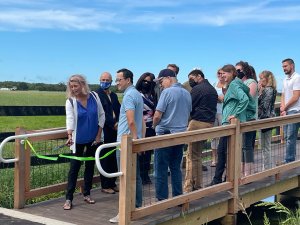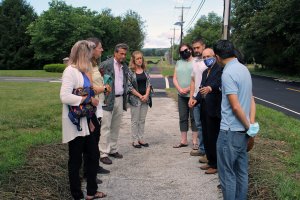
Officials gathered to celebrate the opening of a new asphalt trail along the Skillman Road Pathway in Montgomery Township, NJ. Photo ©Montgomery Township.
This summer local officials celebrated the grand opening of a new 2-mile asphalt trail along the Skillman Road Pathway in Montgomery Township, NJ. In partnership with NJDOT, FHWA, and Rutgers CAIT, the pathway includes areas of experimental porous concrete designed to alleviate flooding and puddling in the area — which researchers will now be studying for performance and service life in the field.
Porous, or pervious, concrete is one type of green infrastructure that can provide environmental benefits in areas prone to flooding as its innovative design allows water to pass through it, effectively reducing flooding, puddling, and assisting groundwater recharge.
On Friday, July 9th, officials and residents in Montgomery Township, NJ celebrated the opening of a new pathway that incorporates this porous concrete design into a 2-mile trail along Skillman Road connecting pedestrians and residents to parks and recreation in the area.
The special concrete was added as part of a pilot project between Montgomery Township, the New Jersey Department of Transportation (NJDOT), the Federal Highway Administration (FHWA), and Rutgers Center for Advanced Infrastructure and Transportation (CAIT).
Dr. Husam Najm, a professor in the department of civil and environmental engineering at Rutgers and a CAIT-affiliated researcher, said that the more commonly used impervious concrete does not allow water to seep through, so in areas prone to flooding that can result in puddling and stormwater runoff. The porous concrete used in this installation incorporates larger size aggregate and has a rougher texture than traditional concrete that allows water to flow through it, protecting the area from flooding and stormwater runoff, puddling, and replenishing the ground underneath.
“We built different types of porous sections along the pathway in order to study and learn how the different mixtures behave in a real world environment,” Dr. Najm said. “While pervious concrete is generally made up of cement, water and sand, certain segments here contain different levels of sand and we believe this will give us new insight on the range of service life, environmental benefits, and life cycle costs.”
While much is known about the benefits of porous concrete for surface runoff mitigation, Dr. Najm added that there is still much researchers hope to learn about how this design compares to traditional methods when it comes to structural longevity and durability in the field.

Dr. Husam Najm shows Montgomery Twp. Mayor Devra Keenan (front left) and Committeeperson Kent Huang (front right), materials used to create the three lengths of innovative pervious pavement. Photo ©Montgomery Township.
Officials said that the pathway has been underway for a long time, and that the new construction aligns with the idea of “complete streets,” promoting connectivity in the community as well as providing additional resources for walkers and cyclists.
For the porous section, researchers said that In January 2020 the team began surveying possible implementation sites, before ultimately choosing the Skillman Road Pathway. Read more here about how the porous concrete project began and the goals of the research.
Dr. Najm said that the long-term goal of this research project is to study different maintenance and construction practices, as well as how different mixtures perform over time, so that more towns and counties can begin to implement this innovative pavement design and make informed asset management decisions.
“Not only will we learn a lot about how this pavement performs on sidewalks and pathways in Montgomery, but we will also learn about how people react to the different material,” he said. “All of this is important data that can inform the future adoption and uses of porous concrete in the state and nationwide.”

